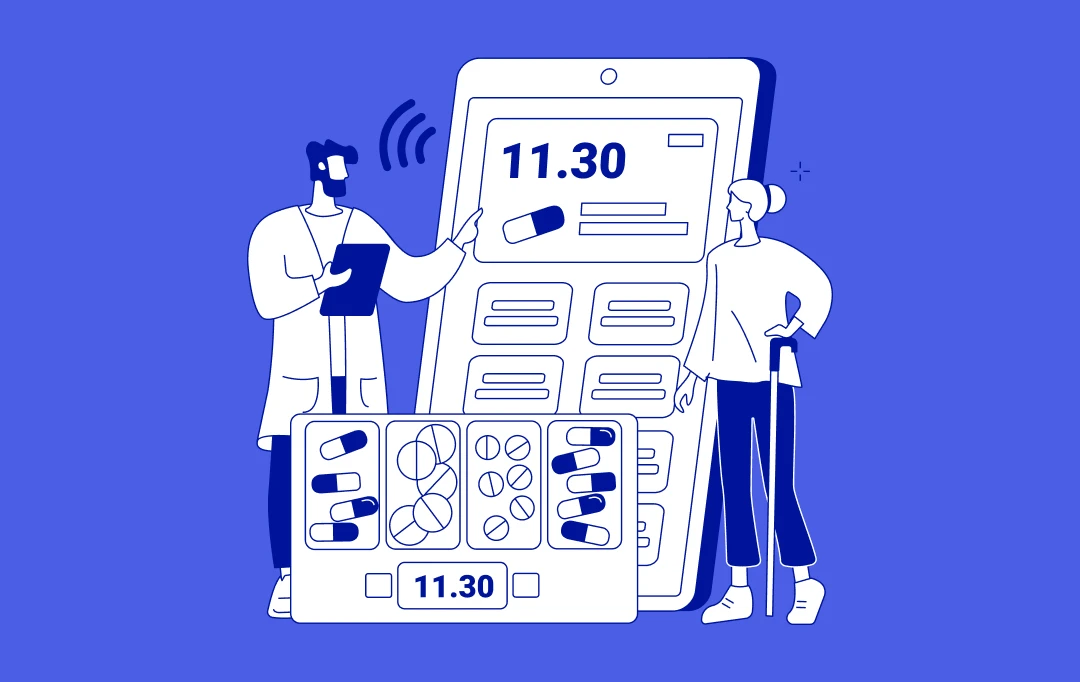- Steps to Develop a Medicine Delivery App: A Strategic Approach
- Understand the Market and Define Your Goals
- Define Key Features
- Choose the Right Technology Stack
- Develop a User-Friendly Design
- Ensure Regulatory Compliance
- Focus on App Development and Testing
- Launch and Market Your App
- Essential Features to Develop A Medicine Delivery App
- Customer Panel Features
- Pharmacist Panel Features
- Admin Panel Features
- Future-Ready Features That Make Your Medicine Delivery App Outperform Your Competitors
- Teleconsultation
- Voice Search Capability
- Predictive Medicine Restocking & Auto-Refills
- Smart Health Insights & Personalized Wellness Plans
- Computer Vision for Prescription Scanning
- AI-Powered Fraud Detection & Prescription Validation
- AI-Based Delivery Route Optimization
- Real-World Success Stories of Medicine Delivery Apps
- PillPack
- Capsule
- MedExpress
- How Much Does It Cost to Develop A Medicine Delivery App
- Key Factors Affecting the Cost of Developing a Medicine Delivery App
- App Complexity and Features
- Platform Choice
- Design and User Interface
- Development Team Location
- Technology Stack
- Third-Party Integrations
- Monetization Strategies for a Medicine Delivery App
- Why Building a Medicine Delivery App is a Smart Move
- Convenience and Accessibility
- 24/7 Availability
- Wider Customer Reach
- Improved Customer Retention
- Better Inventory Management
- Efficient Delivery and Tracking
- Cost Savings
- Regulatory Compliance
- Addressing the Key Challenges in Online Medicine Delivery App Development
- Regulatory Compliance
- Real-Time Inventory Management
- Prescription Verification
- Delivery Logistics
- User Trust and Accessibility
- Scalability and Performance
- Partner with Appinventiv to Build Your Custom Medicine Delivery App
- FAQs
- Q. How much does it cost to build a custom medicine delivery app?
- Q. How long does it take to develop a medicine delivery app?
- Q. What are the best practices for developing a medicine delivery app?
- Q. How Do Medicine Delivery Apps Work?
- Q. Why invest in medicine delivery app development?
The COVID-19 and standard protocols followed during the pandemic, like social distancing, have not only transformed how we survive but also influenced how we access healthcare facilities. During this catastrophic situation, people have turned to digital platforms for everything from groceries to personal care, and the healthcare industry is witnessing a similar shift.
The growing demand for convenient access to medications and healthcare services has led to the rise of on demand medicine delivery app development, offering a new way for individuals to manage their health from the comfort of their homes. Nowadays, along with medicine delivery app, medical courier apps have also become vital in this ecosystem, ensuring timely and secure delivery of prescriptions, medical supplies, and even diagnostic samples, bridging the gap between healthcare providers and patients with efficiency and care.
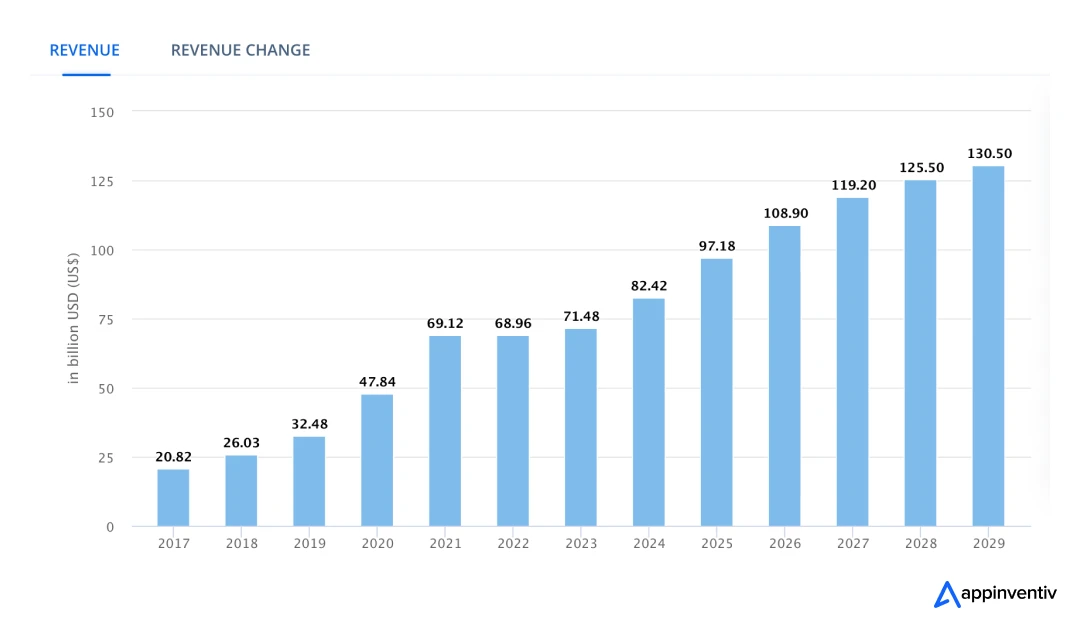
According to Statista, revenue in the Online Pharmacy market is projected to reach $97.18 billion in 2025. This is followed by an expected annual growth rate (CAGR 2025-2029) of 7.65%, driving the market volume to $130.50 billion by 2029.
In light of this growing demand, let’s explore the development process of a custom medicine delivery app, including its features, benefits, and how it is revolutionizing healthcare access.
Steps to Develop a Medicine Delivery App: A Strategic Approach
Building a custom medicine delivery app involves careful planning, execution, and deployment to meet the specific needs of customers and healthcare providers.
Before diving into the steps to develop a medicine delivery app, you need to focus on the user journey of your app and then plan for the design & development of your app. Here’s the overview of how your users will use your medicine delivery app:

Here’s a step-by-step medicine delivery app development process to help you build an effective app.
Understand the Market and Define Your Goals
Analyze the market to identify customer pain points, such as medication availability or delivery delays. Define your app’s primary goals: enhance user experience, streamline pharmacy operations, or improve delivery efficiency. A well-defined objective ensures your medicine delivery software development aligns with user needs.
Define Key Features
Identify and integrate features that cater to customers, pharmacists, and administrators. It includes prescription uploads, order tracking, and secure payment options for users. For pharmacists, ensure inventory management, while the admin panel should handle reporting, user management, and app analytics for smooth operations.
Choose the Right Technology Stack
Select technologies that support scalability, security, and performance. Use frameworks like React Native for cross-platform development, secure cloud storage for data, and secure API development for payment gateways and map integration. A robust stack ensures a seamless user experience.
Develop a User-Friendly Design
Create an intuitive and visually appealing interface that prioritizes user needs. Simplify navigation, include a clear call-to-action, and design features like medication search and prescription uploads for easy access. A good design significantly enhances user satisfaction.
Ensure Regulatory Compliance
Medicine delivery apps must comply with regulations like HIPAA or GDPR to safeguard sensitive health data. Partner with legal advisors to ensure your app adheres to regional healthcare and data privacy laws, building trust with your users.
Focus on App Development and Testing
Develop the app in phases, starting with an MVP (Minimum Viable Product) phase to test core features. Use agile development to incorporate feedback and refine functionalities. Conduct rigorous testing to eliminate bugs and optimize performance.
Launch and Market Your App
Once your app is tested and ready, launch it on app stores with a strategic marketing plan. Promote your app using social media, SEO, and partnerships with pharmacies. Update features regularly and address user feedback to maintain relevance.
Essential Features to Develop A Medicine Delivery App
To ensure your medicine delivery app meets customer expectations and operates smoothly, it must include comprehensive features tailored for all stakeholders: customers, pharmacists, and administrators. Here’s an overview of the essential features of a medicine delivery app:
Customer Panel Features
- User Registration and Login: Simplify account creation using email, phone, or social media.
- Prescription Upload: Allow users to upload prescriptions for validation and order processing.
- Search and Filters: Help users search medicines by name, category, or health condition.
- Order Tracking: Provide real-time updates on order status, including dispatch and delivery timelines.
- Payment Integration: Enable multiple payment options, including cards, wallets, UPI, and insurance.
- Medication Reminders: Notify users about medicine intake or prescription refill schedules.
- Order History: Let users easily view past purchases and reorder frequently bought medicines.
Pharmacist Panel Features
- Inventory Management: Monitor stock levels, set low-stock alerts, and restock as needed.
- Order Management: View, confirm, and prepare orders efficiently.
- Prescription Verification: Validate uploaded prescriptions to ensure compliance with regulations.
- Sales Tracking: Access detailed reports on sales, profit margins, and transaction history.
- Real-Time Notifications: Receive alerts for new orders, customer queries, or restocking requirements.
- Delivery Coordination: Manage delivery schedules and track dispatched orders.
- Feedback Management: Review customer feedback and improve service quality accordingly.
- Data Analytics: Pharma data analytics ensures computational analysis of data or statistics related to pharmacy operations.
Admin Panel Features
- User and Pharmacy Management: Add, manage, or deactivate user and pharmacy accounts.
- Medication Management: As a feature or standalone functionality of the medication management app development, it helps patients manage their medication regimens.
- Analytics Dashboard: Track app performance metrics such as active users, sales, and delivery times.
- Promotion and Discounts: Configure and manage discounts, offers, and loyalty programs.
- Order Monitoring: Oversee all orders to ensure timely processing and delivery.
- Revenue Management: Track financial data, including payments received, refunds, and commissions.
- Data Security: Ensure compliance with data protection regulations such as GDPR or HIPAA.
- Complaint Resolution: Address customer and pharmacy complaints promptly through a support system.
Future-Ready Features That Make Your Medicine Delivery App Outperform Your Competitors
The online medicine delivery industry is growing fast. To keep up, businesses need to develop features that enhance user experience, improve access, and ensure smooth service delivery. Below are some of the top features that can give your medicine delivery app a distinctive edge.
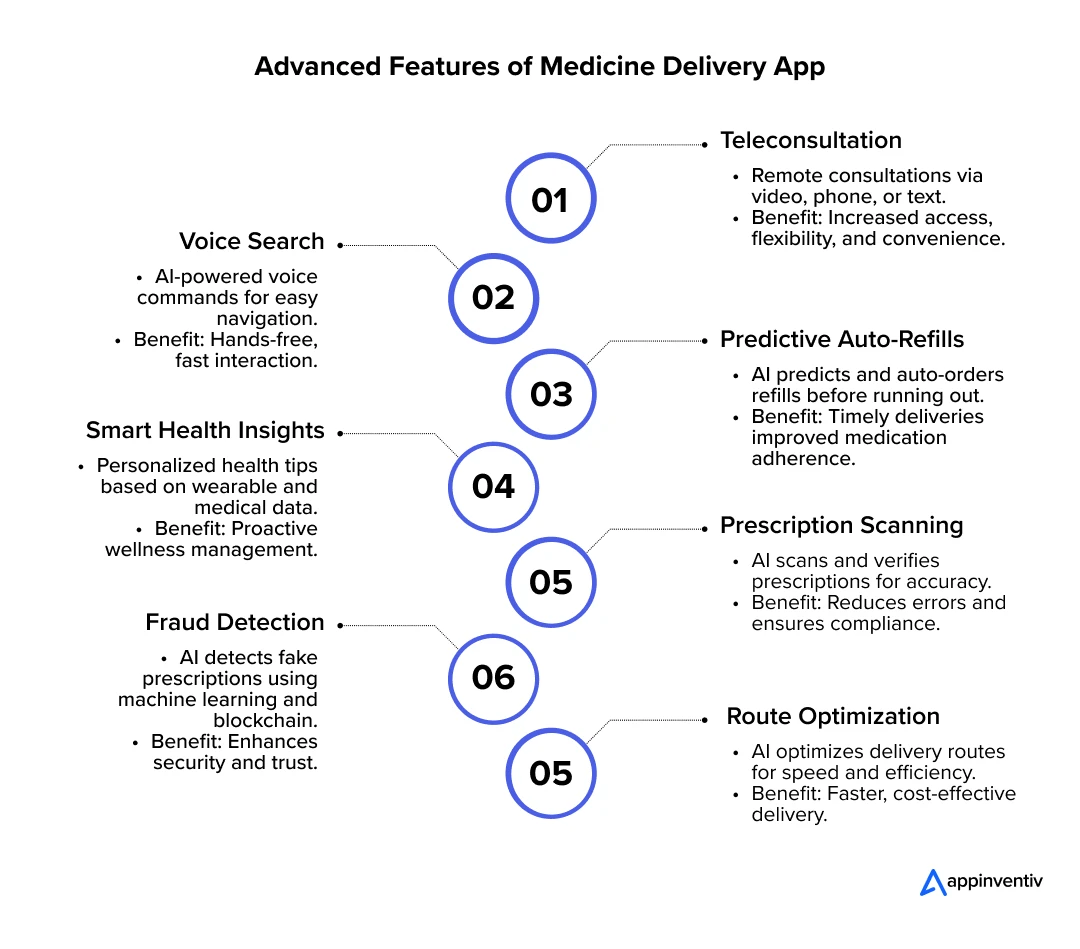
Teleconsultation
Teleconsultation refers to offering medical consultations through remote digital means, such as video, phone, or message services, instead of in-person follow-ups. Various health calls with doctors are increasingly used to suit patients’ needs and enable flexibility for improved access to medical services, especially in remote areas with limited infrastructure.
How Teleconsultation Works
Patient Initiation and Appointment Scheduling
The first step for patients would be to schedule an appointment through the teleconsultation platform or app. This is done through:
- Mobile Apps: Patients book consultations via dedicated health apps, where they can choose a preferred doctor, time, and consultation type.
- Healthcare Providers’ Websites: Many hospitals and clinics allow booking teleconsultations through their websites.
- Phone Calls: Some platforms also allow booking via phone, especially for those less tech-savvy.
Medical History & Pre-Consultation Information
Before the consultation, patients typically provide:
- Health History: Information like current medications, past diagnoses, and ongoing health issues.
- Symptoms: A brief description of the symptoms or concerns the patient wants to bring up during the consultation.
- Tests or Reports: Patients may be asked to attach lab results or medical records if these are related to the consultation.
This data helps the doctor prepare for the consultation and ensures more accurate guidance.
Consultation via Video, Voice, or Text
During the consultation:
- Video Calls: The patient and doctor engage via video conferencing, allowing face-to-face interaction. This is the most common form of teleconsultation as it closely replicates in-person visits.
- Phone Calls: If video isn’t an option, a phone call is used, though this limits the doctor’s ability to examine the patient visually.
- Text-Based Chat: Patients can interact with healthcare providers through secure messaging platforms for less urgent or routine consultations.
Voice Search Capability
Voice technology in healthcare has become a popular trend that improves patient care and eases the accessibility of healthcare services for patients. Using AI and Natural Language Processing (NLP), voice search capability allows users to interact with devices and platforms through voice commands instead of traditional text-based inputs.
How Voice Search Capability Works
Speech Recognition & Audio Processing
Voice search begins with the user’s voice input. The speech recognition system processes the audio signal by:
- Sound Wave Capture: The microphone captures the sound of the user’s voice.
- Signal Conversion: The sound waves are converted into a digital format (text) by algorithms that analyze phonetics, accents, and context.
This is where technologies like Automatic Speech Recognition (ASR) come in, transcribing spoken words into text.
Natural Language Processing (NLP)
Once the speech is transcribed, NLP algorithms help the system understand the meaning and intent behind the words. NLP breaks down the query by:
- Syntax & Semantics: Analyzing grammar and structure of the sentence.
- Entity Recognition: Identifying keywords or entities (e.g., locations, products, people).
- Context Understanding: Machine learning applications in healthcare also interpret context based on past interactions, recent queries, or location.
Query Matching & Response Generation
After processing the voice command, the AI-powered system matches the query to relevant data:
- Search Engines: Voice queries can trigger searches across the web or a specific database to find answers.
- Platform-Specific Data: In an app, voice search might trigger relevant content, product recommendations, or personalized information based on past interactions.
The response is then generated, often using either spoken or text-based feedback, depending on the interface. The system may offer:
- Direct Answers: Simple, direct answers to queries (e.g., “What’s the weather today?”).
- Action Completion: Performing tasks such as ordering, setting reminders, or checking appointments.
Predictive Medicine Restocking & Auto-Refills
AI-powered predictive medicine restocking and auto-refills help pharmacies, healthcare providers, and patients manage medications more efficiently. By analyzing data and anticipating when medications run out, AI can ensure that prescriptions are automatically refilled or restocked before they run low. This can lead to better patient adherence to treatment plans, reduced errors, and a more seamless healthcare experience.
How Predictive Medicine Restocking & Auto-Refills Work
Data Collection & Monitoring
AI collects and analyzes data from various sources:
- Prescription Records: Information about the patient’s medications, dosages, and refill schedule.
- Patient Adherence: Tracking when patients take their medication or request refills using connected devices (e.g., smart pill bottles) or health apps.
- Inventory Levels: Data from pharmacies on current stock levels of medications.
Predictive Analytics for Restocking
AI uses predictive analytics to forecast when a patient will need a refill based on:
- Previous Refill Patterns: Analyzing historical refill patterns (e.g., every 30 days) to predict the next refill date.
- Patient Behavior: Considering factors like whether the patient tends to request refills early or late or how often they miss doses.
- Medication Half-Life: Accounting for how long the medication lasts in the patient’s system to predict their need for a new prescription.
AI ensures the restocking schedule accounts for these variables, ensuring accuracy and timely delivery.
Auto-Refill Activation
Once the system predicts that a refill is needed, it can automatically:
- Notify Patients: Inform patients beforehand that a refill is due and ask for confirmation or approval.
- Trigger Pharmacy Action: Automatically trigger a refill request to the pharmacy, which can then process and ship the medication without requiring the patient to order it manually.
- Adjust for Medication Changes: If a medication dosage or schedule changes, AI can update the restocking system in real-time, ensuring the right amount of medication is dispensed at the right time.
Medication Stock Level Management
Pharmacies can integrate predictive medicine restocking with their inventory management systems. AI monitors stock levels and predicts future needs based on:
- Customer Demand: Predicting when certain medications will be in high demand based on refill patterns and market conditions (e.g., flu season).
- Supply Chain Optimization: Analyzing suppliers’ delivery schedules to predict when stock will need to be replenished to avoid shortages.
AI helps pharmacies maintain optimal stock levels, reducing waste and preventing medication shortages.
Smart Health Insights & Personalized Wellness Plans
AI-driven smart health insights and personalized wellness plans transform how individuals approach their health and wellness. These technologies use data, machine learning, and advanced analytics to create tailored health recommendations based on individual needs, goals, and preferences.
How Smart Health Insights & Personalized Wellness Plans Work:
Data Collection & Integration
Smart health systems gather data from various sources, such as:
- Wearable Devices: Fitness trackers, smartwatches, heart rate monitors, and sleep trackers.
- Medical Records: Health histories, diagnoses, medications, and lab results.
- Behavioral Data: Activity levels, eating habits, and mental health patterns.
AI aggregates and analyzes this data to view an individual’s health and lifestyle comprehensively.
Personalized Health Risk Assessment
AI algorithms analyze personal health data to identify any potential health risks, such as:
- Cardiovascular health: Risk of heart disease or high blood pressure.
- Mental health: Identifying early signs of stress, anxiety, or depression.
- Diabetes Risk: Identifying potential risk factors for type 2 diabetes based on diet and activity.
AI compares individual risk profiles against large datasets to predict future health outcomes, providing users with insight into areas that require attention.
Predictive Analytics & Proactive Health Management
AI uses predictive models to foresee potential health issues before they occur. For example:
- Chronic Condition Monitoring: AI can predict worsening conditions for people with chronic diseases and recommend preventive actions.
- Emergency Alerts: If critical health data (such as sudden blood pressure or heart rate) is detected, AI can alert the user or health professionals.
This proactive approach ensures that individuals can manage their health more effectively, preventing problems before they escalate.
Computer Vision for Prescription Scanning
Computer vision, powered by artificial intelligence (AI), plays a critical role in prescription scanning by enabling automated extraction and validation of prescription information. Computer vision in healthcare enhances efficiency, reduces errors, and increases security in the healthcare delivery process. Here’s how it works:
How Computer Vision for Prescription Scanning Works
Image Capture & Preprocessing
Users capture an image of their prescription using their smartphone or other devices. The image is then preprocessed to enhance its quality, adjusting for lighting, blurring, and distortions to ensure the details are clear and legible.
Optical Character Recognition (OCR)
Once the image is cleaned, AI-powered Optical Character Recognition (OCR) extracts text from the prescription. OCR detects and converts written characters (like the doctor’s instructions, drug names, and dosage details) into machine-readable data.
Text Validation & Cross-Referencing
Once the information is extracted, computer vision cross-checks these details with a medical database to verify the accuracy and authenticity of the prescription. This includes matching drug names with approved formulations, confirming correct dosages, and verifying the doctor’s credentials.
Forgery Detection & Anomaly Detection
Computer vision can detect irregularities in the prescription image, like inconsistent handwriting, unusual fonts, or smudges, which may suggest tampering or forgery. AI analyzes these discrepancies by comparing the image to known fraudulent patterns and applying machine learning (ML) algorithms to improve detection over time.
AI-Powered Fraud Detection & Prescription Validation
Fraudulent prescriptions and counterfeit medicine sales significantly risk public health and regulatory compliance. AI-powered fraud detection and prescription validation can help medicine delivery apps ensure authenticity, security, and compliance while enhancing user trust.
How AI-Powered Fraud Detection & Prescription Validation Works
OCR & Computer Vision for Prescription Scanning
- Users upload a prescription by taking a photo.
- AI, powered by Optical Character Recognition (OCR) and computer vision, extracts details like medicine names, doctor signatures, and expiration dates.
- The system cross-checks with a licensed database to verify authenticity.
Fake Prescription Detection Using AI
- AI detects tampered, altered, or forged prescriptions by comparing uploaded images against a database of known fraudulent patterns.
- Machine Learning (ML) models identify unusual formatting, handwriting mismatches, and inconsistencies.
Blockchain-Powered Prescription Validation
- Securely stores prescription records on the blockchain, ensuring tamper-proof and verifiable prescriptions.
- Provides a transparent, trackable system to detect prescription fraud.
AI-Based Delivery Route Optimization
Efficient and timely medicine delivery is crucial for customer satisfaction, especially when dealing with emergency prescriptions. AI-based Delivery Route Optimization can significantly enhance delivery efficiency, minimize delays, and reduce operational costs.
How AI-Based Delivery Route Optimization Works
Real-Time Traffic Analysis
AI-powered algorithms analyze live traffic conditions, road closures, weather disruptions, and congestion patterns to determine the fastest and most efficient delivery route.
Dynamic Route Adjustments
If an unexpected delay (e.g., accidents, or roadblocks) occurs, AI reroutes the delivery agent in real time to minimize disruptions.
Multi-Stop Route Optimization
AI calculates the most efficient sequence for multiple deliveries in one trip to reduce fuel consumption and minimize delivery time.
AI-Enabled Delivery Slot Predictions
AI predicts optimal delivery windows based on historical data, allowing customers to select the most suitable time for on-time delivery.
Predictive Demand-Based Routing
Using historical sales and seasonal demand trends, AI pre-positions delivery agents closer to high-order areas, reducing response time.
Real-World Success Stories of Medicine Delivery Apps
Here are some real-world examples of medicine delivery apps that make a difference in the healthcare industry. Let’s explore how these apps are improving accessibility and convenience for patients.
PillPack
Application: PillPack, acquired by Amazon, has transformed how patients manage their medications.
Usability: It offers pre-sorted, daily-dose packages delivered directly to customers’ homes, ensuring convenience and accuracy.
Benefits: The app caters to individuals with multiple prescriptions, reducing the chances of dosage errors.
Capsule
Application: Capsule is a prime example of innovation in the pharmacy sector, offering same-day delivery for prescriptions.
Usability: This pharmacy delivery app development allows users to upload prescriptions, consult with pharmacists, and track their orders in real-time.
Benefits: It eliminates the need to visit a pharmacy, saves time and provides unparalleled convenience.
MedExpress
Application: MedExpress, a trusted name in the online pharmacy, has revolutionized how people access medications globally.
Usability: The platform offers an extensive range of prescription and over-the-counter medicines, health products, and even virtual consultations, making it a comprehensive healthcare solution.
Benefits: Its user-friendly app ensures secure prescription uploads for accurate and timely order processing.
These real-world examples showcase how drug delivery app development redefines healthcare by prioritizing user convenience, affordability, and comprehensive services.
How Much Does It Cost to Develop A Medicine Delivery App
The cost of developing a medicine delivery app can vary significantly based on several factors, including the app’s complexity, the development team’s location, and the features included. Below is a detailed breakdown of the key factors influencing the medicine delivery app development cost:
| Type of Application | Cost Estimation | Time Duration |
|---|---|---|
| Basic | $40,000 to $60,000 | 2-3 months |
| Intermediate | $60,000 to $90,000 | 3-6 months |
| Advanced | $90,000 to $300,000 | 9+ months |
How to Estimate the Cost of Developing a Medicine Delivery App: A Simple Formula
Estimating the cost of creating a medicine delivery app involves two key factors: the total number of development hours needed and the hourly rate charged by the development team.
Here’s a simple formula to calculate the overall cost to build a custom medicine delivery app:
Total Cost = Development Hours × Hourly Rate
Key Factors Affecting the Cost of Developing a Medicine Delivery App
The cost of developing a medicine delivery app can vary significantly based on several factors, including the app’s complexity, the development team’s location, and the features included. Below is a detailed breakdown of the key factors influencing the cost:
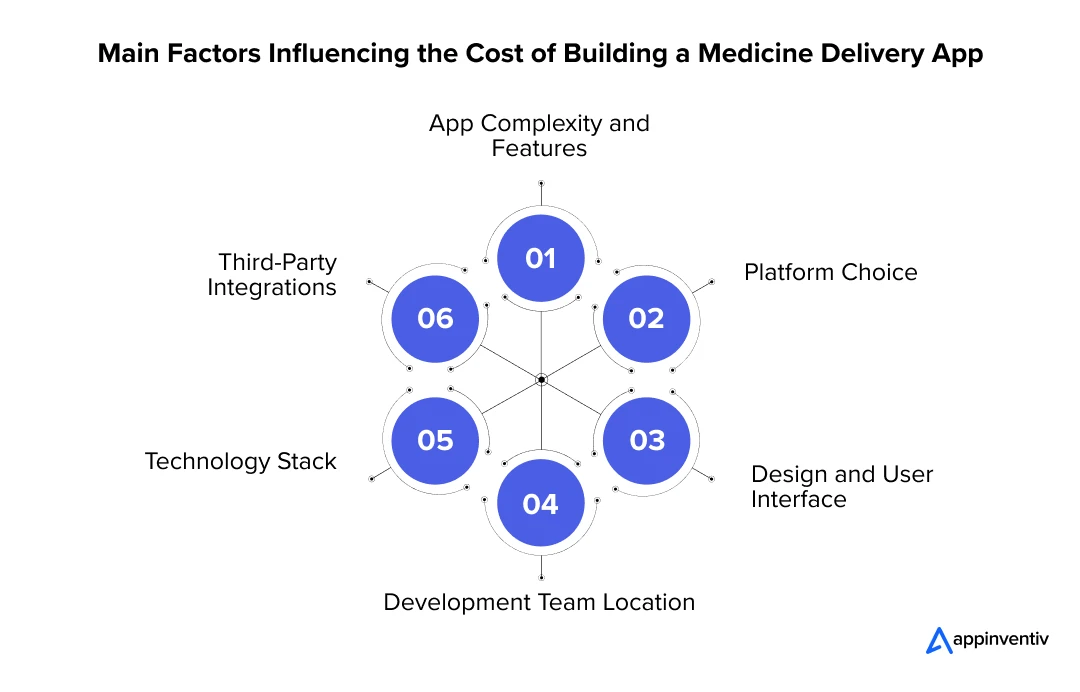
App Complexity and Features
The features of a medicine delivery app vary based on business needs. A basic app includes user registration, medicine search, order placement, and delivery tracking. More advanced features may include AI-powered intelligent models, virtual consultations, and integration with health records, enhancing the customer experience.
Cost Comparison Based on Design Complexity
| Design Complexity | Estimated Cost |
|---|---|
| Basic UI/UX Design | $6,000 – $30,000 |
| Custom/Advanced UI/UX Design | $30,000 – $50,000+ |
Platform Choice
Deciding between a single platform (iOS or Android) or a cross-platform approach is crucial to build a custom medicine delivery app. A single-platform app targets a specific user base, while a cross-platform app offers wider accessibility on both iOS and Android devices, reaching more users.
Cost Comparison Based on Platform Choice
| Platform | Estimated Cost |
|---|---|
| Single Platform (iOS or Android) | $30,000 – $100,000 |
| Cross-Platform (iOS and Android) | $100,000 – $300,000+ |
Design and User Interface
For a medicine delivery application development, a clean, easy-to-navigate design is essential. Features like clear medicine categorization, an easy prescription upload feature, and a smooth checkout process are vital for improving user experience and ensuring satisfaction.
Development Team Location
The location of your medicine delivery application development team influences the quality and cost of the app. Outsourcing app development team familiar with the healthcare industry and regulatory standards ensures the app meets user expectations and legal requirements, especially for handling sensitive health data.
| App Development Team | Hourly Rates (Approx) |
|---|---|
| Project Manager | $25 to $30 |
| Tech Lead (Backend / Frontend) | $28 to $30 |
| Sr. Mobile App Developer | $25 to $30 |
| Sr. Web & Backend Developer | $24 to $30 |
| DevOps | $25 to $30 |
| Business Analyst | $20 to $25 |
| UX/UI | $20 to $25 |
| QA | $20 to $25 |
Technology Stack
Choosing the right technology stack for online medicine delivery app development vital for app functionality. The prescription delivery app development needs to integrate GPS for tracking, secure payment gateways, and prescription verification systems to ensure smooth, safe, and efficient operation.
| Tech Stack | Cost Estimation |
|---|---|
| Basic Tech Stack (React Native, Flutter, PHP) | $50,000 – $120,000 |
| Advanced Tech Stack (Python, AI, Blockchain) | $120,000 – $250,000+ |
Third-Party Integrations
Third-party integrations like robust payment gateways, GPS, inventory management, and prescription validation systems improve app efficiency. These tools streamline operations, reduce manual work, and enhance the user experience with real-time updates and secure transactions, felicitates in medication delivery app development.
Cost Comparison Based on Third-Party Integrations
| Third-Party Integration | Estimated Cost |
|---|---|
| Basic Integration (Single Payment Gateway) | $2,000 – $10,000 |
| Complex Integration (GPS, Multiple APIs, Real-Time Analytics) | $5,000 – $15,000+ |
Monetization Strategies for a Medicine Delivery App
Monetizing a custom medicine delivery app can be approached through various strategies to ensure sustainable revenue generation. Some effective monetization strategies methods include:
- Delivery Fees: Charging a nominal fee for each delivery ensures consistent revenue. You can offer different delivery speed options, such as express or scheduled deliveries, allowing customers to choose based on their needs and willingness to pay.
- Subscription Model: By offering subscription plans, you can provide users with regular, scheduled deliveries of their medications at discounted rates. This creates a steady income stream and builds customer loyalty while making it convenient for users to get their medicine on time.
- Commission from Pharmacies: Partnering with local pharmacies and taking a commission on each sale made through the app is a reliable revenue stream. Pharmacies benefit from the added exposure while you generate revenue from the orders placed via your platform.
- Partnership with Insurance Companies: Integrating health insurance providers to deliver medications to insured patients opens up another revenue stream. By partnering with insurance companies, you can earn commissions on the medication delivery services, making it a mutually beneficial arrangement.
Why Building a Medicine Delivery App is a Smart Move
Here are the benefits of medicine delivery apps for businesses: TheyThey offer personalized solutions for streamlined order processing, enhance customer convenience with tailored features, and ensure seamless integration with healthcare systems for efficient delivery management.
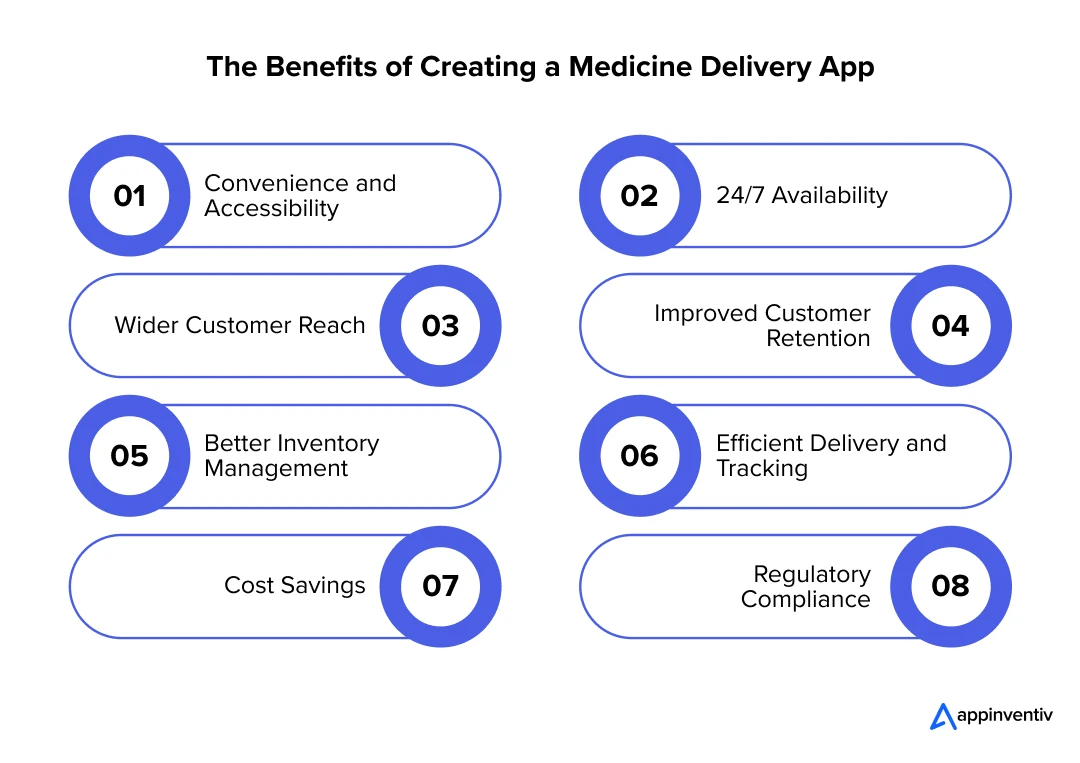
Convenience and Accessibility
A medicine delivery app solution significantly enhances customers’ convenience by allowing them to order their medications from anywhere at any time. This is especially beneficial for individuals with mobility challenges, elderly patients, or people living in remote areas where access to physical pharmacies may be limited.
With just a few taps, customers can have their prescribed medications delivered straight to their doorsteps, making medicine delivery app development services more accessible and user-friendly.
24/7 Availability
One of the key advantages of a medicine delivery app is its ability to operate 24/7. Unlike traditional pharmacies with fixed operating hours, an app ensures that users can place orders for medications at any time of the day or night, which is especially useful for emergencies or after-hours needs.
This constant availability improves customer satisfaction and ensures they can access critical medications whenever needed, providing peace of mind.
Wider Customer Reach
A medicine delivery app breaks geographical barriers by allowing pharmacies to serve a broader customer base. It reaches individuals in urban, suburban, and rural areas, enabling customers from all over to access essential medicines without the need to visit a physical store.
By expanding your reach to new regions and customer segments, your business can capture a more diverse audience, ultimately driving growth and increasing revenue potential.
Improved Customer Retention
Medicine delivery apps improve customer retention by offering features that enhance the user experience. Repeat order functionality, personalized medicine recommendations, and easy tracking options make it easier for users to place orders and stay connected to the service.
The pharmacy delivery app development can also send reminders for prescription refills, encouraging customers to return regularly. These convenience-driven features help foster customer loyalty, leading to long-term relationships and recurring business.
Better Inventory Management
Managing inventory efficiently becomes more streamlined with a medicine delivery app. The pharmacy delivery app development provides real-time updates on stock levels, helping pharmacists track inventory automatically.
This minimizes the risk of running out of stock or overstocking, ensuring that the right medications are available when customers need them. Additionally, the system can alert pharmacy staff when it’s time to reorder supplies, improving stock control and preventing shortages or surpluses.
Efficient Delivery and Tracking
A medicine delivery app enhances delivery efficiency by integrating tracking features that allow customers to follow their order’s progress in real-time. This transparency reduces uncertainty and helps build trust with customers, who appreciate knowing exactly when their medications will arrive.
Delivery management features, such as optimized routing and automatic delivery updates, ensure that orders are processed quickly and efficiently, improving customer satisfaction and operational efficiency.
Cost Savings
By automating critical tasks like order processing, inventory tracking, and delivery management, a medicine delivery app can help reduce operational costs. The app minimizes manual work, such as phone orders or physical inventory checks, allowing staff to focus on higher-value tasks.
Additionally, the digital nature of the service eliminates the need for maintaining a brick-and-mortar location, further lowering overhead medicine delivery app development costs and maximizing profit margins.
Regulatory Compliance
A well-designed medicine delivery app helps pharmacies comply with industry regulations and ensures the secure handling of sensitive customer data. With features like encrypted data storage, secure payment gateways, and authentication measures, the app meets privacy standards such as HIPAA (Health Insurance Portability and Accountability Act) in many regions.
This adherence to regulatory requirements ensures that the pharmacy delivery app development provides a safe and secure service to customers and helps the business avoid legal issues.
After exploring the benefits of medicine delivery apps for businesses, let’s examine their essential features.
Addressing the Key Challenges in Online Medicine Delivery App Development
Developing a medicine delivery app comes with unique challenges, such as ensuring regulatory compliance, managing real-time inventory, and maintaining secure logistics.
However, innovative solutions like AI-driven prescription verification, robust data security measures, and optimized logistics systems can effectively address these challenges. Let’s explore these challenges and their solutions for app development for medicine delivery.
Regulatory Compliance
Challenge
Adhering to healthcare regulations like HIPAA, GDPR, or local laws is a major hurdle, as apps handle sensitive health data.
Solution
Implement robust encryption, secure data storage, and access controls. Regular audits and updates to align with legal requirements ensure compliance and build user trust.
Real-Time Inventory Management
Challenge
Synchronizing inventory across multiple pharmacies can lead to errors or delays in fulfilling orders.
Solution
Integrate real-time inventory management systems with pharmacy databases. Automated updates and notifications can prevent stockouts and improve efficiency.
Prescription Verification
Challenge
Validating prescriptions without compromising user experience is complex and time-sensitive.
Solution
Use AI-driven tools for automatic prescription scanning and verification. This will ensure regulatory compliance while maintaining a smooth user experience.
Delivery Logistics
Challenge
Ensuring timely and accurate delivery, especially for critical medications, can be logistically challenging.
Solution
Leverage GPS-based route optimization and integrate with local courier services. Real-time tracking and notifications can keep users informed and reduce delivery times, strengthening medication delivery app development.
User Trust and Accessibility
Challenge
Gaining users’ trust, especially when handling health data, and ensuring the app is accessible to all demographics.
Solution
Incorporate transparent privacy policies, secure authentication methods, and simple navigation. Accessibility features like large fonts and voice commands can cater to a wider audience.
Scalability and Performance
Challenge
Scaling the app to handle growing user traffic without performance degradation is crucial.
Solution
Build a scalable backend architecture using cloud solutions. Regular performance testing and load balancing can ensure reliability during peak times.
By proactively addressing these challenges with strategic solutions, an online medicine delivery app development company can create top-notch apps that are secure, efficient, and user-friendly.
Partner with Appinventiv to Build Your Custom Medicine Delivery App
Appinventiv is a leading healthcare app development company committed to transforming healthcare through innovative digital solutions. With extensive expertise in medicine delivery apps, we specialize in building secure, user-friendly platforms tailored to your business vision.
1. 3000+ Successful Projects: Proven excellence across diverse industries, delivering impactful solutions.
2. 1600+ Experts Worldwide: A global team dedicated to personalized, result-driven app development for medicine delivery.
3. Seamless Development: Client-first approach ensuring transparency, timely delivery, and customization.
4. Proven Success Stories: Our track record is reinforced by client testimonials highlighting our ability to deliver successful projects that significantly enhance healthcare ops along with patient care.
5. Award-Winning Innovation: Recognized as ‘Tech Company of the Year’ at the Times Business
Collaborate with Appinventiv to design and launch a next-gen medicine delivery app that transforms healthcare delivery and provides exceptional value to users.
FAQs
Q. How much does it cost to build a custom medicine delivery app?
A. The medicine delivery app development cost depends on several factors, such as features, complexity, and the development team’s location. The average price can range from $40,000 to $300,000 or more. Factors like app design, integration payment gateways, real-time tracking, and regulatory compliance influence the overall cost.
Q. How long does it take to develop a medicine delivery app?
A. The development timeline for a custom medicine delivery app typically spans 3 to 6 months, depending on the app’s features and complexity. The timeline can vary based on the project’s scope, such as integration with third-party services, UI/UX design, and testing for performance and security.
Q. What are the best practices for developing a medicine delivery app?
A. Developing a medicine delivery app requires complying with regulations like HIPAA and GDPR to protect user data. A simple, user-friendly design and secure payment integration are essential for a smooth user experience. Real-time tracking and AI-powered prescription validation ensure accuracy and transparency. A scalable backend supports growth, while integration with local pharmacies helps manage inventory. Strong security measures like encryption and multi-factor authentication system should be prioritized. Finally, ongoing testing and quality assurance ensure a bug-free, reliable app.
Q. How Do Medicine Delivery Apps Work?
A. Medicine delivery apps work by connecting customers with pharmacies through a digital platform. Users can browse available medicines, upload prescriptions, and place orders directly through the app. Once the order is confirmed, the app coordinates with partnered pharmacies and delivers the ordered medicines.
These medicine delivery app development solutions help healthcare businesses manage orders, inventory, and deliveries, ensuring a smooth user experience.
Q. Why invest in medicine delivery app development?
A. Investing in medicine or pharmacy app development allows businesses to meet rising consumer demands for convenience, timely deliveries, and contactless purchases. With expert medicine delivery app development services, you can build a scalable, compliant, and user-friendly platform that drives customer loyalty and operational efficiency.
So, if you want to create your medicine delivery app, contact us now.


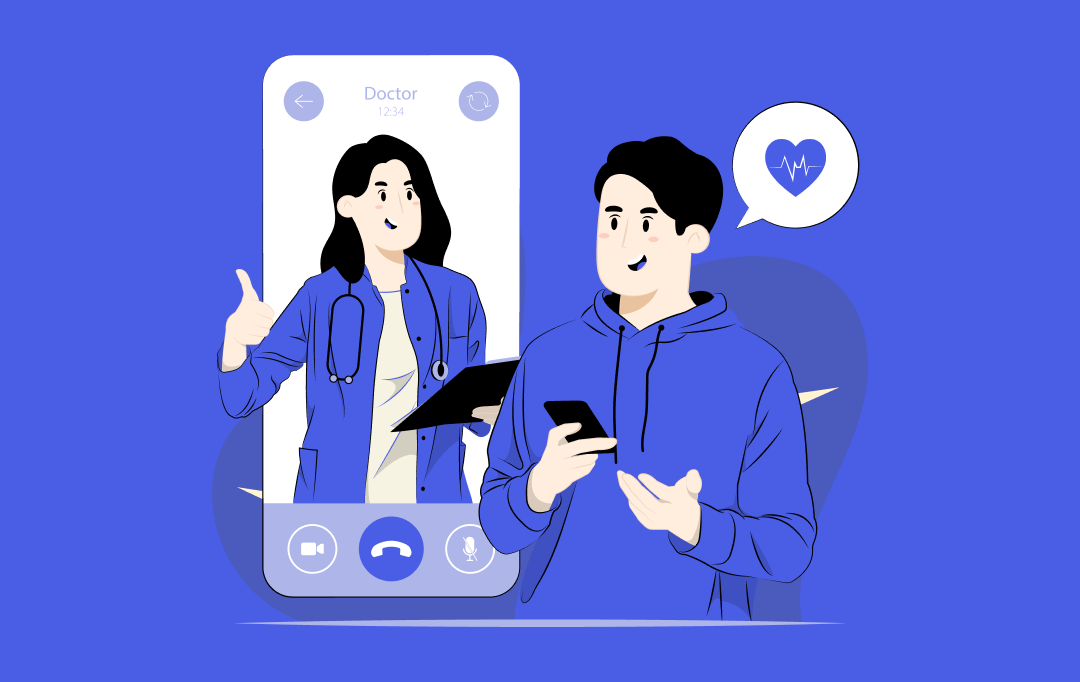
Why Telehealth Security is Non-Negotiable for Patient Trust and How to Achieve It
Key takeaways: Telehealth security is crucial for patient trust and the continued adoption of digital healthcare services. The rising tide of cyber threats, from ransomware to inadequate authentication, poses significant risks to patient data and provider reputation. Implementing robust security measures like end-to-end encryption, multi-factor authentication, and regular audits is non-negotiable. Compliance with regulations like…
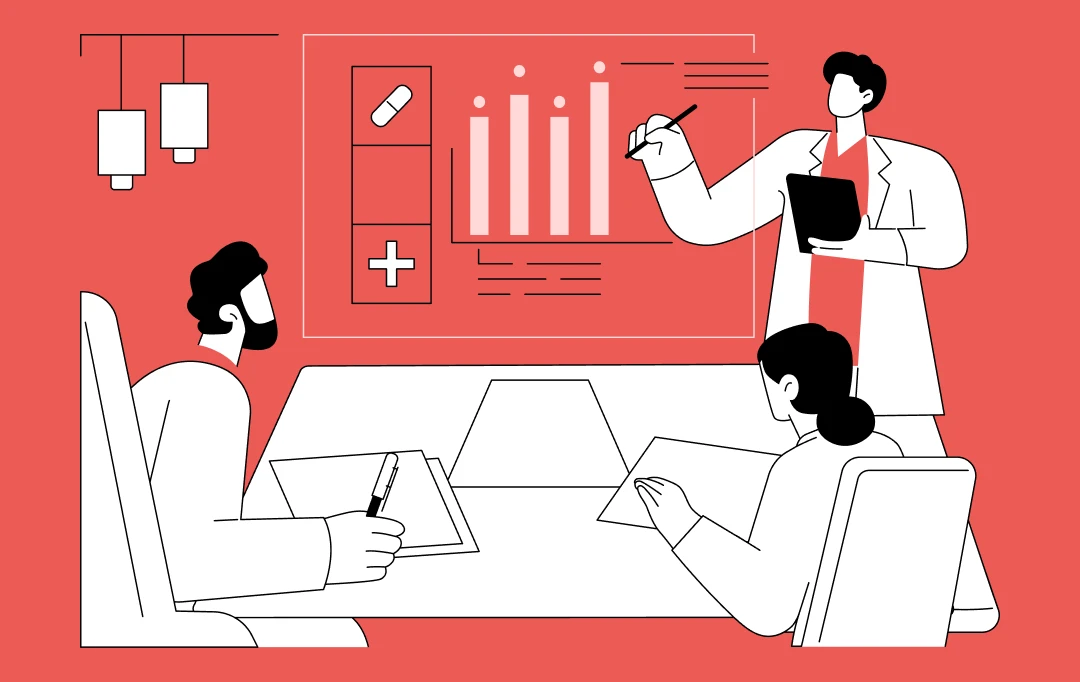
10 Ways Healthcare Providers Are Using Patient Analytics to Enhance Care Plans and Optimize Outcomes
Imagine a world where doctors don’t just react to health crises, but predict and prevent them before they happen. This is the reality with patient analytics for healthcare providers. The healthcare industry is no longer limited to treating symptoms—it’s now about understanding patterns, making smarter decisions, and delivering care that’s truly personalized. And it’s not…

Exploring the Role of Personalization in Healthcare through Technology
Key takeaways: Personalization in healthcare transforms patient care from generic, population-based treatments to individualized approaches tailored to each patient's unique needs. Advanced technologies like AI, IoMT, and genomics are the core enablers for tailoring medical treatments. Personalization drives significant benefits, including improved patient outcomes, higher engagement, and reduced costs. The future of healthcare is hyper-individualized,…






